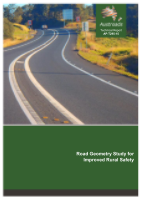Road Safety

- Publication no: AP-T295-15
- ISBN: 978-1-925294-42-2
- Published: 29 May 2015
- PDF (free) Download
This report draws on literature and crash data analysis to identify and quantify geometric road design elements which contribute to casualty crash occurrence and severity on rural roads, e.g. lack of sealed shoulders, steep downhill grades combined with curves, roadsides with narrow offset to roadside hazards, and high-flow rural at-grade intersections. These findings were supported by a before and after evaluation of casualty crash reductions expected from shoulder sealing, pavement widening and road realignment.
Combining this evidence and inputs by the Austroads Road Design Task Force, the report proposes a number of possible changes to Austroads road design guides aimed at reducing the casualty crash risk on rural roads. Most proposed changes involve clarification of guidance, e.g. for selection of design speed in challenging alignments, use of speed limits to control speeds, use of sealed shoulders, selection of barriers and clear zones, and greater guidance for design of low speed roundabouts.
A Commentary is provided discussing the usefulness of different types of evidence in revision of road engineering guidance. It is intended to make it easier for policy makers to select and commission the most appropriate inputs for consideration.
- Summary
- 1. Introduction
- 1.1. Background
- 1.2. Objectives of this Study
- 2. Methods
- 2.1. Crash Data Analysis
- 2.2. Literature Review
- 2.3. Before and After Evaluation
- 2.3.1. Data Collection
- 2.3.2. Analysis
- 2.4. Consultation on Design Guidance Changes
- 2.5. Commentary
- 3. Rural Casualty Crashes
- 3.1. Extent of the Rural Casualty Crash Problem
- 3.2. Characteristics of Rural Casualty Crashes
- 3.3. Rural Casualty Crashes and Geometric Design
- 4. Rural Road Design Elements and Crash Risk
- 4.1. Horizontal Alignment
- 4.2. Vertical Alignment
- 4.3. Cross-section
- 4.4. Roadsides
- 4.5. Intersections
- 5. Evaluation of Selected Road Design Element Improvements
- 5.1. Road Design Elements Data
- 5.2. Crash Reduction Factors
- 5.3. Crash Severity Ratios
- 5.4. Summary and Interpretation of Results
- 6. Design Elements for Improved Rural Road Safety
- 6.1. Horizontal Alignment
- 6.1.1. Design Speed
- 6.1.2. Curvature and Grade
- 6.1.3. Curve Delineation and Warning
- 6.1.4. Perceptual Solutions
- 6.2. Vertical Alignment
- 6.3. Cross-section
- 6.3.1. Sealing Shoulders
- 6.3.2. Providing Unsealed Shoulders
- 6.3.3. Sealed Shoulder Widening on the Outer Edge of the Curve
- 6.3.4. Painted Medians
- 6.3.5. Barriers in Painted Medians
- 6.3.6. Gateway Treatments
- 6.4. Roadsides
- 6.5. Intersections
- 6.5.1. General Crash Risk Reduction Principles
- 6.5.2. Roundabouts
- 6.5.3. Turbo Roundabouts
- 6.5.4. Priority-controlled Intersections
- 7. Discussion
- 7.1. Rural Crash Data Analysis
- 7.2. Literature Reviews
- 7.3. Evaluation of Selected Road Design Elements
- 7.4. Relevance of Findings to Safe System Implementation
- 8. Conclusions and Proposed Actions
- 8.1. Workshop
- 8.2. Project Findings and Task Force Directions
- References
- Appendix A Geometric Design Elements and Crash Risk
- A.1 Horizontal Alignment
- A.1.1 Curve Radius
- A.1.2 Curve Combinations
- A.1.3 Superelevation
- A.2 Vertical Alignment
- A.2.1 Vertical Grades
- A.2.2 Vertical Curves
- A.2.3 Summary
- A.3 Cross-section
- A.3.1 Pavement Widths
- A.3.2 Lane Widths
- A.3.3 Shoulder Width
- A.3.4 Lane and Shoulder Width
- A.3.5 Lane Separation
- A.3.6 Embankments
- A.3.7 Summary
- A.4 Intersections
- A.4.1 Type of Intersection
- A.4.2 Superelevation through an Intersection
- A.4.3 Intersection Sight Distance
- A.4.4 Summary
- A.5 Motorcycles and Heavy Vehicles
- A.5.1 Motorcyclists
- Length of curve
- Curve radius
- Distance from the end of the curve
- Shoulder width
- A.5.2 Heavy Vehicles
- Lane widths
- Sight distance
- Other projects
- A.5.3 Summary
- Appendix B New Road Design Elements
- B.1 Horizontal Geometry
- B.1.1 Curve Widening
- Description
- Effectiveness
- B.1.2 Optical Speed Bars
- Description
- Effectiveness
- B.1.3 Summary
- B.2 Intersection Treatments
- B.2.1 Turbo Roundabouts
- Capacity
- Safety Benefits
- B.2.2 Jug Handle Intersection
- Safety Benefits
- B.2.3 Intersection Narrowing
- B.2.4 Raised Platforms
- B.2.5 Reducing Sight Distance
- B.2.6 Summary
- B.3 Cross-section
- B.3.1 Single Lane Cross-section, 2 – 1 Roads
- Effectiveness
- B.3.2 Lane and Shoulder Combinations
- B.3.3 Medians
- Wide Painted Medians
- B.3.4 2 + 1 Roads
- B.3.5 Summary
- B.4 Gateway Treatments
- B.4.1 Introduction
- B.4.2 Pavement Marking
- Converging Chevrons
- Speed Marking and Lane Narrowing
- Safety Benefits
- B.4.3 Summary
- B.5 ‘Self-explaining’ Roads
- Commentary 1
- C1.1 Reasons for Road Design Guidelines Review
- C1.1.1 Update
- C1.1.2 Policy Change
- C1.1.3 Input from Other Professions
- C1.2 Road Design Guidelines Review Process
- C1.3 Evidence for Review of Specific Road Design Guidance
- C1.3.1 Reviews of Other Guidelines
- C1.3.2 Audit Feedback
- C1.3.3 Review of Published Research
- C1.3.4 Before and After Studies
- C1.3.5 Frequency Analysis
- C1.3.6 Statistical Regression Models
- C1.3.7 Theoretical Models
- C1.3.8 Design Testing
